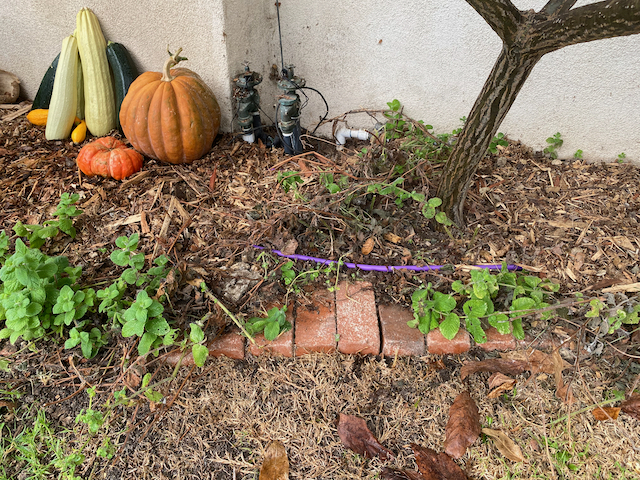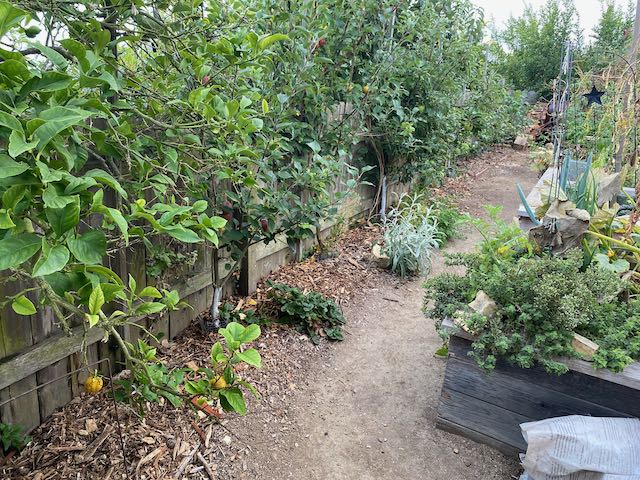Getting Bids
Two greywater companies and four plumbing companies came out to bid the job. The highest bid came from Greywater Corps (greywatercorps.com) and they charged $400 to bid both the greywater and a rainwater project. Out of four plumbers, only 3 gave me bids and they were the next three in terms of total price, but they didn’t have the experience of the greywater companies. The least expensive bid came from Earth Steward Ecology (earthstewardecology.com), based in Long Beach. Ryan Serano, the owner, charged $175 to come out on June 2nd, 2023 and bid both the greywater and another second project for rainwater capture. The bid arrived on June 27th and I called Ryan to tell him he got the job.
It took almost three months between the time I told Ryan he got the job and when actual work commenced on September 19th. I was glad to have the time to have a Chip Drop delivered so I could have enough mulch to cover the greywater line if they needed it. I used most of the Chip Drop to mulch my back yard and the Dirt Lockers. Earth Steward Ecology ended up using just a small amount (about 1 cubic yard) of the chips.
Pump or Gravity Fed?
Installing a pump basin where water is collected temporarily and pumped into the greywater line is more expensive than a gravity fed system, but the later requires that your property be sloped 1/4 inch down every foot of distance from your house. A pump can get the water anywhere you need it, even uphill or across flat distances. My property slopes toward the street, but the amount of digging that would have been necessary to lay the line out at 1 inch of slope every four feet made it prohibitive. Plus, pumping the water meant I could send it in other directions besides just toward the street.
Where to put the pump reservoir (basin)
It makes sense to have the pump at a place where the water is collected near enough to the house that it is holding water draining from your bathrooms and/or washing machine while also near an outdoor electrical outlet or electricity source. The water drains into the pump basin via gravity, so the team had to dig a very deep hole at the corner of my house near where the sewer line runs. My house has a crawl space, and the team spent quite a few days under the house fitting greywater piping from one sink in my master bath (the other sink had too tight an area to fit the greywater piping, so it still drains to the sewer line, but luckily I don’t use that sink very much) and two sinks in the other bathroom, plus both tub drains in the master and the second bathroom. I have a third bathroom that we didn’t capture because they would have had to drill through two concrete foundation walls under the house. The first two bathrooms are the main source of greywater, and the team also captured the water from my washing machine. Washing machines have their own pump so you can move water uphill and therefore, it doesn’t matter if the greywater pump reservoir is uphill from the washer.
Each sink has its own “actuator”
What if you want to put Draino or Liquid Plumber down your drain to clear out a clog? You can still do that IF you have a switch that changes the effluent drain from greywater to sewerline. The team installed switches that activate a diverter valve that directs the flow to either the greywater pipes or the sewer pipes. The actuator switch was installed inside my sink cabinets. The washing machine also has an actuator switch so that if I wanted to use bleach, I could make sure that water goes to the sewer line.
What kind of soaps can be used?
You may have to switch to biodegradable products.
I didn’t have to switch because I already use biodegradable soaps, essential oils, and environmentally sound products. I checked with the company that sells my favorite shampoos and conditioners and they assured me their products are safe for greywater. Here are the products I use:
Dolce Mia: hair and skin products, fantastic scents DolceMia.com
Miracle Soap: for body wash, shampoo, and washing the tubs and sinks; basically it washes everything. AzureStandard.com sells it here: https://www.azurestandard.com/shop/product/health-beauty/bath-shower/soap/liquid/natural/regular-soap/9247?package=HB665
Lemongrass Spa: face washes, all non-toxic ingredients
Laundry Detergent: Charlie’s Soap at Azure Standard: https://www.azurestandard.com/shop/product/household-family/laundry/detergent/liquid/regular/laundry-liquid/12024?package=NF142
What was it like to work with Earth Steward Ecology?
The crew consisted of three men: Ryan Serano who is a licensed plumber, and his employees Noé and Ian who are apprentice plumbers. They came at 9:30 in the morning the first day, and most days they arrived between 8:50 and 9:30 am. They almost always parked in my driveway, necessitating moving their vehicles before I could get out of the garage to leave. But they were always gracious about it and very quick to act.
The crew often worked half days and didn’t come back after lunch. Sometimes they would leave at 1:00, sometimes as late as 1:30, and not come back until the next day or a few days later. Ryan was trying to complete another large job during my project, so he would pull his crew off my job and not come back for several days. This didn’t bother me much because I’m a patient person. Plus, since most of the work was done under the house or outside, it didn’t impact my enjoyment of the house. My favorite thing about the crew was that they were very clean. They would take their shoes off to come through the house, they would vacuum whatever they were working on. They left very little trash and what trash they did leave took almost no time to clean up. When they left their tools and supplies at the house, they put those items in places where I would not have trouble moving around. All in all they were very considerate and respectful. I was really impressed when Ryan bought some touch-up paint that exactly matched the wall behind my washer/drier. I had told him not to bother because, after all, it was behind the washer/drier and I never look back there. He wanted to make sure it was perfect.
Problems occurred:
The piping under the house ran into problems. The crew had to drill through difficult concrete blocked areas, they had to fit into tight spaces, some of which made the job prohibitive (such as under one of the sinks in the master bath), and drilling through two areas of my foundation were quite laborious. They also ran into a problem when the cleanout line was in the way of their pump reservoir’s line. They did a workaround after discussing it for some time. Each problem was met with patience and creative problem-solving. The job took longer than they could have anticipated. And yet, in no instance did Ryan tell me he needed to increase the cost.
How long did it take to install?
Work was completed on October 13th, about 3 1/2 weeks after they started.
Summary
I won’t know until two water billing cycles if the cost of my bill will really decrease.
But I do know that only one zone is now watered by the greywater line, and I have a total of 14 watering zones. I don’t expect much of a savings.
What I do enjoy, is that I don’t have to think twice about taking long showers or filling the bathtub up for a bath. I won’t annoy my daughter by asking her to finish her shower quickly. Instead of having the water go right into the sewer lines, it is going to feed a whole lot of fruit trees (there are a total of 13 fruit trees and 8 rosebushes on that zone).
What if I go on vacation? How will the trees get watered?
I don’t want my trees to suffer if I leave and there’s no showers or sink usage. So Ryan set up the greywater system to accept water from one of the valves of my city water irrigation system. So, all I have to do before I leave is turn that one valve back on by programming the controller to deliver water a certain number of minutes. It’s already programmed for frequency and start times.
What does it look like?

The greywater tubing is purple; all repurposed water lines are purple wherever the landscaper captures and directs effluent from greywater sources. The tubing is 1/2 inch thick and has emitters every 12 inches, same as Netafim or the Rainwater dripline or Toro’s dripline has. If you have a gravity-fed system, there is no purple tubing. It’s done with pipe, splitter valves, and mulch basins. Earth Steward Ecology had to put more than one ring around most of my trees, as they are mature and need a lot of ground covered to feed all the roots to the dripline of the tree canopy.

The backflow prevention technique:
Ryan said he installed two valves in the line between the city water source and the pump basin, each one being a one-way valve. Water can only go in one direction and the flow stops if it tries to reverse. It’s called backflow prevention, so greywater won’t get into the city water lines.
Afterthoughts:
Overall, I give the project a thumb’s up. I started getting bids April 6th and it was completed on October 13th, so please be patient if you decide to make this happen for your house. If you are a DIY’er, Greywater Corps teaches classes for $200 on how to hook up your own system. You can find out about their classes by signing up at their website to receive emails. It’s easier to capture water from a washer since it has its own pump, but getting the water to your landscape is the issue. I have concrete sidewalks ALL the way around my house which made it tricky. You may not have the same issues and your job will go easier.
More photos:



